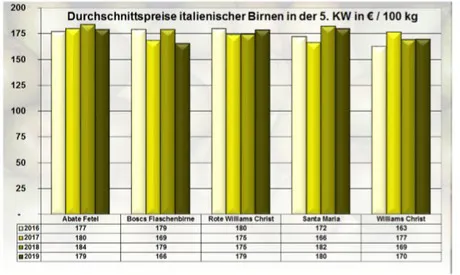Italian shipments continued to dominate the German pear market in a monopolistic way. The amounts of Abate Fetel and Santa Maria shrank. The supply of the two Williams Christs did not change significantly. Domestic Alexander Lucas in 60/70 and 70/80 mm as well as Dutch Conference, Gellert or Alexander Lucas were partly completely marketed, so there weren't any to be found anywhere. Red-cheeked Early Desires from the Netherlands complemented the colorful sector. The trade was moving extremely calmly. Profits were not as expected.

Nevertheless, the sellers were not really willing to adjust their prices. The sparse Central European batches were probably quite stable because of their availability. First lots of South African Bon Chretien appeared at €17,- per 12.5 kg package. These fruits were not able to accelerate the rather sluggish trades.
Apples
Steady sales usually ensured constant prices. because demand was not too noticeable, there was sometimes an oversupply. Prices were lowered here and there, in the hope of reversing the faltering sales.
Pears
The trade was extremely quiet. Profits fell short of expectations. Nevertheless, the traders were unwilling to adjust their prices. First offers of South African Bon Chretien appeared at €17,- per 12.5 kg package.
Table grapes
The search for customers became increasingly difficult. However, promotions sometimes made things easier. But as soon as the smallest deficiencies were recognizable in the fruits, the prices collapsed conspicuously.
Oranges
On the one hand, the interest could quite satisfy, on the other hand, the cold weather did not bring the hoped-for acceleration of sales. Despite overall stability, prices tended to be moderately volatile; certainly on Friday.
Small citrus fruits
The winter weather generally made for lively sales. For some batches of mandarins, therefore, one could get the previous prices, for some batches prices were going up. Here and there, a dip in demand caused lower prices in the middle of the week.
Lemons
For one thing, the cold weather caused rapid sales. Therefore, traders kept their prices at the same levels. On the other hand, plentiful supplies, especially from Turkey, provoked significant discounts.
Bananas
As is expected for this season, business was quiet. The inflows from the ripeners were in harmony with the quite demand. This caused prices to vary only gradually.
Cauliflower
The predominant French lots rivalled complementary batches from Spain and Italy. The primarily quiet demand exacerbated this competition. Sooner or later, prices collapsed everywhere.
Iceberg lettuce
Iceberg lettuce arrived from Spain almost in a monopoly. Initially, they were marketed fairly rigidly. However, availability soon became so widespread that the original price levels plummeted.
Cucumbers
The supply of snake cucumbers constantly exceeded the demand. In order to stimulate sales, the marketers reduced their prices. And they succeeded, because demand then picked up.
Tomatoes
The trade lacks a degree of sales appropriate for the supply, although here and there one saw a friendly demand. Prices tended to go down.
Peppers
Demand was usually very quiet. On the one hand, the prices of the Spanish articles of all colors remained at a constant level, on the other hand they could go up or down, depending on the variety.
